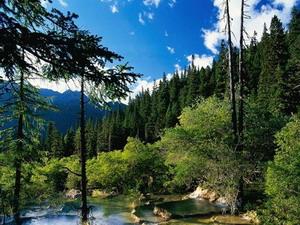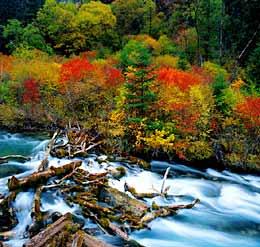Jiuzhaigou Valley Scenic and Historic Interest Area


It is said that if there should be wonderlands on the earth, Jiuzhaigou Valley must be one of them. There is no equal elsewhere that has sceneries and fables of dreamlike eloquence, or natural purities like a fairyland as Jiuzhaigou Valley.
Jiuzhaigou Valley is located in Nanping County, 450 kilometers (about 280 miles) to the north of Chengdu City. Its name is due to the existence of nine stockaded villages of Tibetan origin, and it is always regarded as a holy mountain and watercourse by the Tibetan people.This Valley is a great masterpiece of nature having dreamlike scenery and abundant natural resources. It combines blue lakes, waterfalls, verdant forests, snow-covered mountains, and the folk customs of the Tibetan and Qiang peoples.
This region covers more than 600 square kilometers (about 230 square miles),  and includes areas such as Shuzheng Valley, Rize Valley, Zechawa Valley and Zharu Valley, etc. The main beauty spots such as calc-sinter lake groups, waterfalls, and other waterscapes, as well as 12 summits make Jiuzhaigou Valley a wonderful appearance.
and includes areas such as Shuzheng Valley, Rize Valley, Zechawa Valley and Zharu Valley, etc. The main beauty spots such as calc-sinter lake groups, waterfalls, and other waterscapes, as well as 12 summits make Jiuzhaigou Valley a wonderful appearance.
Legend has it; that long, long ago the deity of mountain named Dago had a crush on the goddess Semo, and he gave a mirror that was made from wind and cloud to the goddess. However, the devil appeared and made trouble to Semo. Inadvertently, Semo broke the mirror into 108 pieces, which fell down to the earth and then turned to 108 colorful lakes. The lake is also called Haizi by local people.
 The place is dotted with more than 100 gorgeous lakes, which differ from others by having a high concentration of calcium carbonate, so that the lakebeds and embankments are all covered with crystals. The water is so clear that the bottom is visible despite depths of several dozen meters. Waterfalls are the essence of the scenery in Jiuzhaigou. They are created between lakes on different levels with water flowing down the cliffs covered
The place is dotted with more than 100 gorgeous lakes, which differ from others by having a high concentration of calcium carbonate, so that the lakebeds and embankments are all covered with crystals. The water is so clear that the bottom is visible despite depths of several dozen meters. Waterfalls are the essence of the scenery in Jiuzhaigou. They are created between lakes on different levels with water flowing down the cliffs covered
with trees. The water actually oozes through the tree trunks into the falls. The trees in the primitive forest are thick with leaves that block the sunlight. As the height and temperature there vary, there is a distinctive distribution of plants, with the broadleaf forest, at the foot of the mountain, and a coniferous forest at the top. In autumn, the mountaintops are covered with white snow while the hill slopes and the valley are a blaze of color.
In 1992, UNESCO entered this scenic area onto the world natural heritage list.


